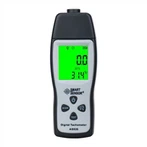How to determine the distance coefficient (optical resolution) of the infrared thermometer?
The distance coefficient is determined by the ratio of D:S, that is, the ratio of the distance D between the probe of the thermometer to the target and the diameter of the target to be measured. If the thermometer must be installed far away from the target due to environmental conditions, and a small target must be measured, a thermometer with high optical resolution should be selected. The higher the optical resolution, i.e. increasing the D:S ratio, the higher the cost of the pyrometer. Raytek Infrared Thermometers D:S range from 2:1 (low distance factor) to over 300:1 (high distance factor). If the thermometer is far away from the target and the target is small, a thermometer with a high distance coefficient should be selected. For a pyrometer with a fixed focal length, the focal point of the optical system is the minimum position of the spot, and the spot near and far from the focal point will increase. There are two distance factors. Therefore, in order to accurately measure temperature at a distance close to and far from the focus, the size of the measured target should be larger than the spot size at the focus. The zoom thermometer has a minimum focus position, which can be adjusted according to the distance to the target. If D:S is increased, the received energy will decrease. If the receiving aperture is not increased, the distance coefficient D:S will be difficult to increase, which will increase the cost of the instrument.
Determine the wavelength range
The emissivity and surface properties of the target material determine the spectral response wavelength of the pyrometer. For high reflectivity alloy materials, there is low or varying emissivity. In the high temperature area, the best wavelength for measuring metal materials is near infrared, and 0.8-1.0 μm can be selected. Other temperature zones can choose 1.6μm, 2.2μm and 3.9μm. Since some materials are transparent at a certain wavelength, infrared energy will penetrate these materials, and a special wavelength should be selected for this material. For example, 1.0μm, 2.2μm and 3.9μm are used to measure the internal temperature of the glass (the measured glass must be very thick, otherwise it will pass through) wavelengths; 5.0μm is used to measure the surface temperature of the glass; For example, 3.43μm is used for measuring polyethylene plastic film, 4.3μm or 7.9μm is used for polyester, and 8-14μm is used for thickness exceeding 0.4mm. For example, the narrow band 4.64μm is used to measure CO in the flame, and 4.47μm is used to measure NO2 in the flame.






